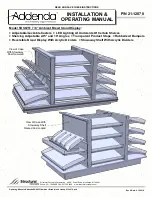
11-9
190-01004-03 Rev. P
GTN 625/635/650 Pilot’s Guide
Weather
11.1.5.1 Reflectivity
Reflectivity is the amount of transmitted power returned to the radar receiver.
Colors on the NEXRAD display directly correlate to the level of detected
reflectivity. Reflectivity as it relates to hazardous weather can be very complex.
The role of radar is essentially to detect moisture in the atmosphere. Simply
put, certain types of weather reflect radar better than others. The intensity of a
radar reflection is not necessarily an indication of the weather hazard level. For
instance, wet hail returns a strong radar reflection, while dry hail does not. Both
wet and dry hail can be extremely hazardous.
The different NEXRAD echo intensities are measured in decibels (dB) relative
to reflectivity (Z). NEXRAD measures the radar reflectivity ratio, or the energy
reflected back to the radar receiver (designated by the letter Z). The value of Z
increases as the returned signal strength increases.
11.1.5.2 NEXRAD Limitations
NEXRAD radar images may have certain limitations:
• NEXRAD base reflectivity does not provide sufficient information to
determine cloud layers or precipitation characteristics. For example, it is
not possible to distinguish between wet snow, wet hail, and rain.
• NEXRAD base reflectivity is sampled at the minimum antenna elevation
angle. An individual NEXRAD site cannot depict high altitude storms at
close ranges. It has no information about storms directly over the site.
• In the Cell Movement function, “Base” height is actually the height of
maximum radar reflection and that the “Base” and “Top” heights are based
on radar height and not MSL or AGL.
• Each square block on the display represents an area of four square
kilometers (2.15 NM). The intensity level reflected by each square
represents the highest level of NEXRAD data sampled within the area.
Summary of Contents for GTN 625
Page 608: ...This page intentionally left blank ...
Page 609: ......
Page 610: ...190 01004 03 Rev P ...




































